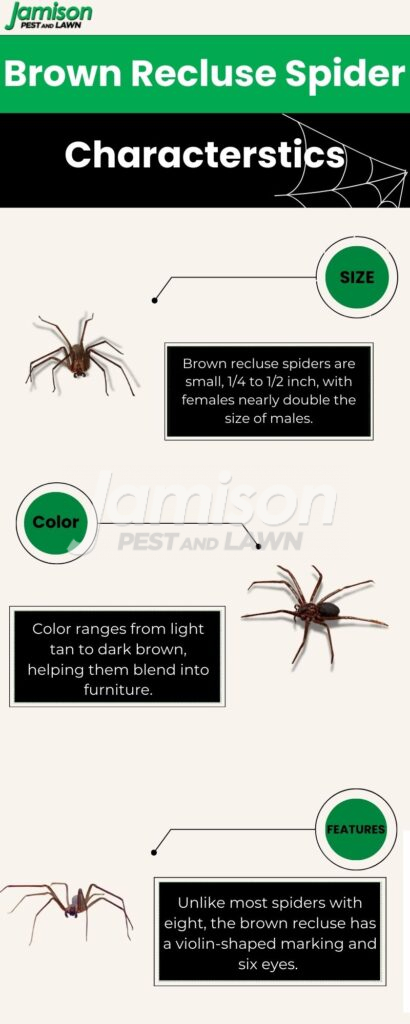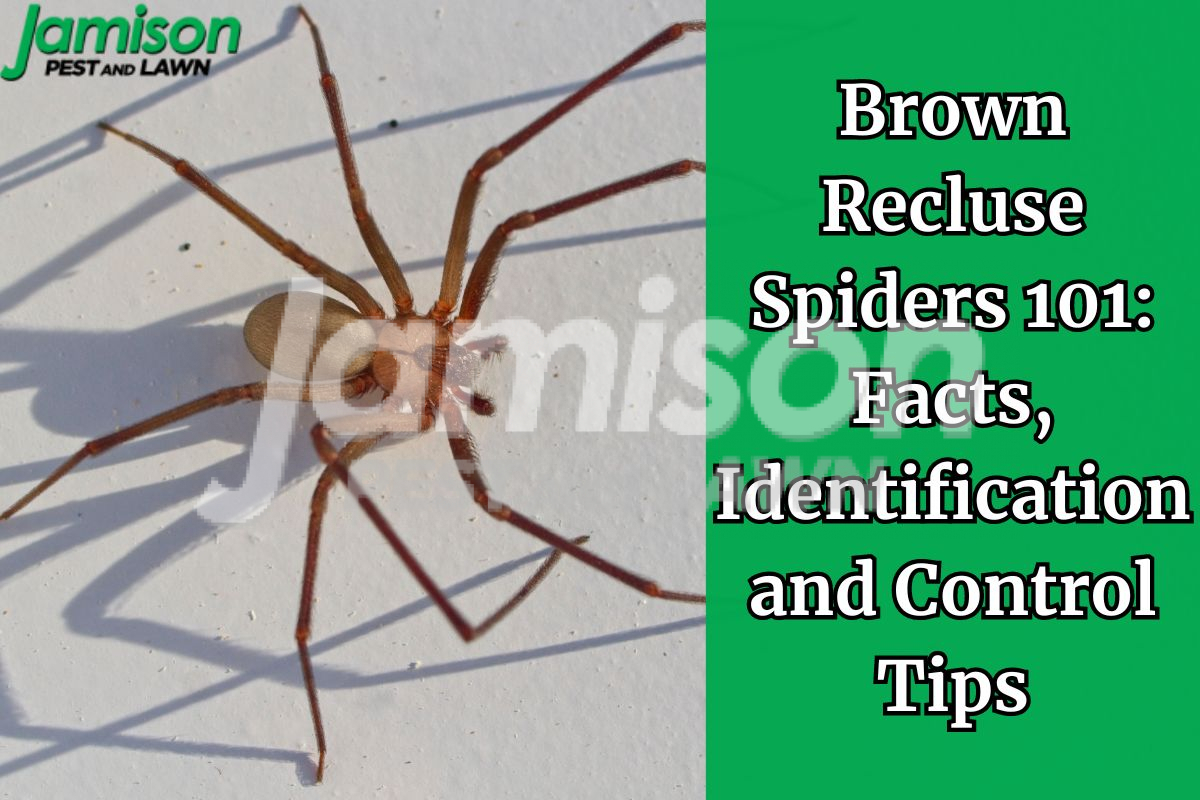Ever wonder if there’s something lurking in those dark corners of your house? Summer is when pests are the most active and can cause harm to you and your property. At Jamison Pest and Lawn, we not only offer the best pest control services but also make sure that homeowners in Tennessee and surrounding areas understand how different bugs and rodents can cause issues around properties.
Today we’re talking about a common spider – the brown recluse. Whether you’ve seen one or just heard stories, it’s good to know the facts. What does a brown recluse spider look like? Where do they hide? And most importantly, how can you keep these out of your home? We’ll answer these questions and more in this blog post.
What Is A Brown Recluse Spider?
The brown recluse spider, often a source of anxiety for homeowners, is known for its potentially harmful bite and is more common than you might think.
The brown recluse spider, scientifically named loxosceles reclusa, belongs to the Sicariidae family. As with the name, these have a light brownish color and have a distinctive, violin-like sign on their back. They are called recluse spiders because they are shy and prefer quiet, out-of-the-way spots where they won’t be bothered.
Known for their solitary nature, these spiders are part of a group that shares similar characteristics across different species.
What is the Habitat Of Brown Recluse Spiders?
Brown recluse spiders are predominantly found in the Midwestern and Southern regions of the United States. So if you are a homeowner in Tennessee, Mississippi, or Alabama, you need to be extra careful. Other predominant states where these are present are Oklahoma, Arkansas, and Louisiana.
While their natural range is limited to these areas, there have been occasional sightings outside this zone, often attributed to accidental transportation via boxes or luggage.
Here is some other information about the habitat of brown recluse spiders.
Preferred Indoor/Outdoor Environments
Within homes, brown recluse spiders favor environments that are warm, dry, and undisturbed. This preference makes attics, basements, and closets ideal locations for them. They are also commonly found behind pictures, under furniture, and in infrequently used clothing or shoes. The reclusive nature of these spiders means they tend to inhabit places that offer plenty of hiding spots.
In outdoor settings, brown recluse spiders seek out similarly secluded environments. They are often found in woodpiles, sheds, and garages, where they can hide among stored items.
Climate Considerations
The climate in the Midwestern and Southern U.S. is particularly conducive to brown recluse habitation due to its warm temperatures and dry conditions. These climatic factors are crucial because brown recluse spiders are less tolerant of colder environments, which limits their spread to regions with mild winters.
What Does A Brown Recluse Spider Look Like?
Now that you know where these spiders like to hide in and around your house, the next question that might come to mind is: “How do I know I have a brown recluse spider in my home?” In this section, we will talk about the physical characteristics of this pesky creature.
What Is The Size Of A Brown Spider?
Unlike some spiders that are large in size, the brown recluse spider is relatively small, with females measuring about 1/4 to 1/2 inch in body length (just about 10-12 millimeters). The female spiders are almost double the size of male brown recluse spiders.
To put this into context, wolf spiders and black spiders are more than 1 inch in length (20-25 millimeters).
What Is The Color Of Brown Recluse Spiders?
These spiders can be anywhere from a light tan to a darker brown color. This range of colors helps them blend in with their surroundings, whether they’re hiding in cardboard boxes, wood piles, or dark corners.
Other Distinctive Features

The most distinctive feature of the brown recluse is the violin-shaped marking on its back, with the neck of the violin pointing toward the rear. This marking has earned it the nickname “fiddleback” spider. However, relying solely on this feature can be misleading, as markings can vary in visibility and shape.
Also, the eyes of these spiders are quite distinct. Unlike most spiders, the brown recluse has only six eyes, arranged in pairs, rather than the typical eight.
Can A Brown Recluse Spider Hurt You?
As we already covered, brown recluse spiders are known for their shy and reclusive nature, preferring to stay hidden and avoid human contact. But when these spiders feel threatened or when they are inadvertently disturbed, they can bite you. While they might seem harmless due to their preference for seclusion, a bite from a brown recluse can cause significant harm.
The venom of a brown recluse spider is necrotic, meaning it can destroy the tissue around the bite. This can lead to severe skin and tissue damage if not treated properly. While bites can cause serious reactions, they are generally harmless.
However, it depends on the amount of venom injected and the individual’s sensitivity to it.
What Treatments Should Be Taken?
While the symptoms are generally mild, immediate care is still needed. Early intervention can help lower the risk of a severe reaction. Treatment typically involves cleaning the wound thoroughly and applying ice packs to reduce swelling. In some cases, doctors may prescribe antibiotics to prevent infection or pain relievers to manage discomfort.
Brown Recluse Spider Bite Symptoms
Initially, a brown recluse spider bite may cause redness, swelling, and a burning sensation at the site. These early symptoms can develop into a blister, which may eventually turn into an open sore. In severe cases, systemic symptoms such as fever, chills, and nausea can occur, indicating a more widespread reaction to the venom.
How To Get Rid Of Brown Recluse Spiders
Dealing with brown recluse spiders in your home can be concerning due to their potential danger. However, you can effectively manage and reduce their presence with the right approach. Here are some practical steps to help you get rid of brown recluse spiders:
Reducing Clutter
Brown recluse spiders thrive in areas where they can hide undisturbed. Start by decluttering your home, especially in attics, basements, closets, and garages. Remove piles of clothes, stacks of papers, and unused boxes, which can serve as ideal hiding spots for these spiders. Regularly sorting through and organizing these spaces will make your home less attractive to them.
Sealing Entry Points
Preventing spiders from entering your home is an essential step in controlling their population. Inspect your home for cracks, gaps, and openings around windows, doors, and the foundation. Seal these entry points with caulk or weather stripping to keep spiders and other pests out. Additionally, ensure that window screens are intact and free of tears.
Using Sticky Traps
Sticky traps are an effective tool for monitoring and reducing spider populations. Place these traps in areas where brown recluse spiders are likely to travel, such as along baseboards, behind furniture, and in corners. These traps can help you identify where spiders are most active and allow you to take targeted action.
Natural Repellents
Consider using natural repellents to deter brown recluse spiders. Some essential oils such as peppermint, eucalyptus, and lavender are known to repel various types of pests including spiders. This is because spiders hate the strong scent just like ants and rats.
Outdoor Maintenance
Maintain your yard and outdoor areas to reduce the likelihood of spiders entering your home. Keep wood piles, rock piles, and debris away from the foundation of your house. Trim vegetation and bushes to prevent them from touching the exterior walls, as these can provide pathways for spiders to enter.
Also Read: How To Get Rid Of Spiders In Memphis, TN
Brown Recluse Vs. Other Spiders
As you know, there is a wide variety of spider species. In Tennessee alone, there are hundreds of types, each of which are likely not wanted in your home. So, how do you differentiate a brown recluse spider from other species? Let’s find out:
Brown Recluse Vs. Wolf Spider
Brown recluse spiders and wolf spiders are often confused due to their similar color and size, but they have distinct differences. Brown recluse spiders are generally smaller, with a body length of about 1/4 to 1/2 inch. In contrast, wolf spiders are larger, often reaching up to 2 inches long.
Brown Recluse Vs. House Spider
Brown recluse spiders are known for the distinctive violin-shaped marking on their back, which is absent in house spiders. House spiders, including common species like the American house spider, typically have a more rounded body shape and are often yellowish-brown. Also, unlike the brown recluse spider, they are more visible in your home.
Spotted A Brown Recluse Spider? Call Us Now
By staying informed and proactive, you can minimize the risks associated with these spiders and coexist peacefully. Remember, the key to managing brown recluse spiders is vigilance and timely action.
If you have seen a brown recluse spider in or near your home, contact the team at Jamison Pest and Lawn at (901) 452-1505 for the best spider control services in the area.




